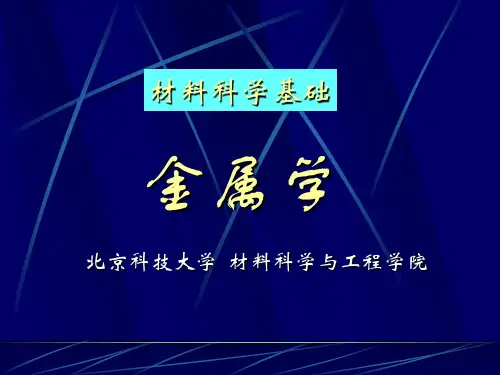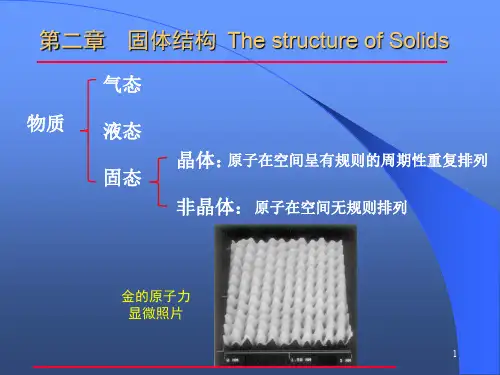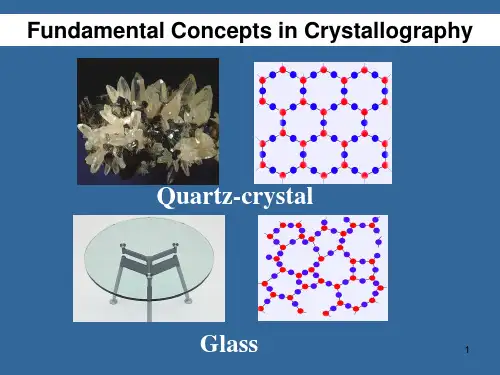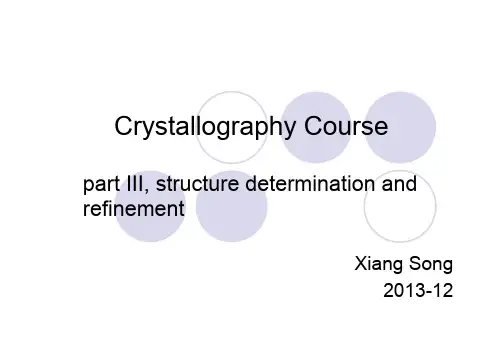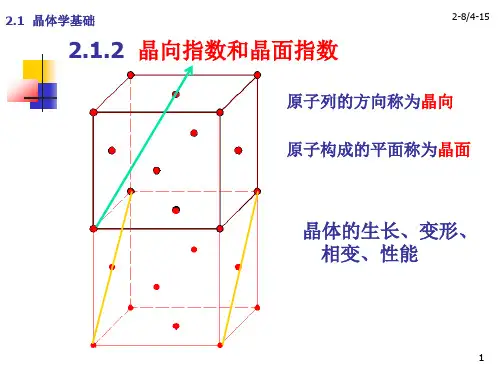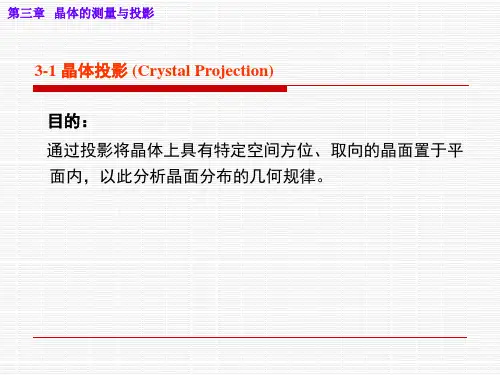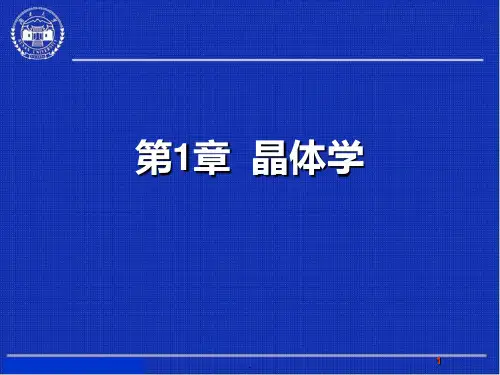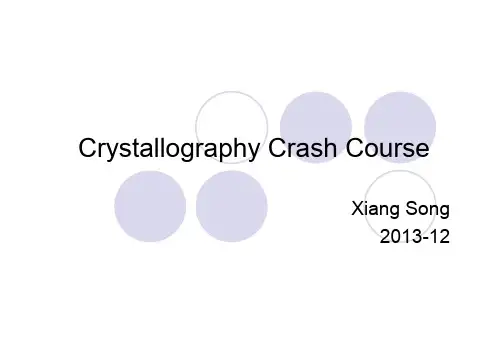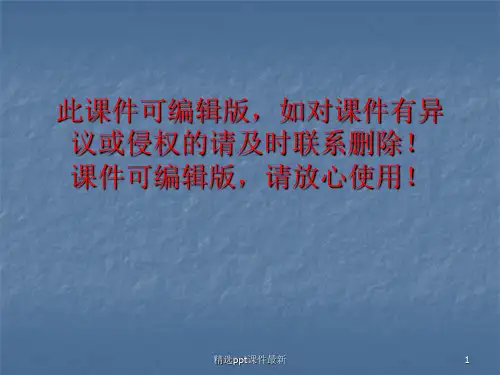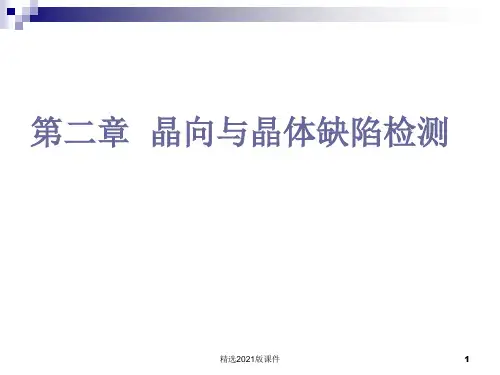- 1、下载文档前请自行甄别文档内容的完整性,平台不提供额外的编辑、内容补充、找答案等附加服务。
- 2、"仅部分预览"的文档,不可在线预览部分如存在完整性等问题,可反馈申请退款(可完整预览的文档不适用该条件!)。
- 3、如文档侵犯您的权益,请联系客服反馈,我们会尽快为您处理(人工客服工作时间:9:00-18:30)。
Math preparations
l Vector summation
Math preparations
Vector products
Dot product
Cross product
Light is a wave
Mathematical representations of light:
A cos ϕ Aeiϕ
A, amplitude, intensity of light is:
I= A
2
φ, phase:
ϕ = ϕ 0 + 2π ( ft + r / λ )
f: light frequency λ: wavelength r: distance
Phase differences of light created by different path-lengths
Diffraction by a crystal with a primitive unit cell
The reciprocal lattices
! ! ! ! Diffracting condition of a crystal is: (ua + vb + wc ) • Δk = n (1) for all possible u, v, w. u, v, w and n are integers. ! ! ! ! Δk can be repsented by a different set of primitive vectors a*, b* and c*: ! ! ! ! Δk = ha* + kb* + l c*, ! ! ! if a*, b* and c* satisfy the following: ! ! ! ! ! ! ! ! ! ! ! ! ! ! ! ! ! ! a* • a=1, a* • b=0, a* • c=0; b* • a=0, b* • b=1, b* • c=0; c* • a=0, c* • b=0, c* • c=1; Diffraction condition of a crystal (equation (1)) becomes: uh+vk+wl=n (2), for all possible u, v, w; hence h, k, l must be integers. ! ! ! The lattice with primitive vectors a*, b*, c* is called the reciprocal lattice, ! ! ! the original lattice with primitive vectors a, b, c is called the direct lattice, h, k, l are called diffraction indexes.
Non-primitive unit cells apply additional restrictions to h, k, l
! For a C-centered cell, for every poistion (reprsented by vector r) in the crystal, ! there are equivelant positions r' that: ! ! ! ! ! ! ! ! ! ! ! ! r ' = r + ua + vb + wc, or r ' = r + ua + vb + wc + 0.5a + 0.5b The diffracting condition (2) becomes: uh + vk + wl = n and uh + vk + wl + 0.5(h + k ) = n for all possible u, v, w. u, v, w and n are integers. Hence in addition to h, k, l must be integers, (h+k) must be an even number. Likewise, for an I-centered unit cell, (h+k+l) must be an even number; for a F-centered cell, (h+k), (h+l) and (k+l) must all be even numbers.
Possible diffractions within a resolution range
1/dmax
O
1/dmin
Reciprocal space
Why X-ray crystallography?
Resolution d=λ/2sin Θ
Data collection setup
Data collection
Real crystals: • Deviations from ideal lattice periodicity causes reciprocal lattice points to grow “fat” • Each diffraction is spread over a range of rotation • Mosaicity of a diffraction is the range of rotation over which it is spread
2π 2π ( BD + BC ) = ( AB cosθ1 + AB cosθ 2 ) λ λ 1 1 = 2π ( AB cosθ1 + AB cosθ 2 ) λ λ ! ! define vectors k1, k 2 of the same direction as the 1 incident and diffracting lights, with amplitudes λ ! ! ! 1 AB cosθ1 = (r1 − r2 ) • (−k1 ) λ ! ! ! 1 AB cosθ 2 = (r1 − r2 ) • k2 λ Δϕ = ! ! ! ! ! ! Δϕ = 2π [(r1 − r2 ) • (−k1 ) + (r1 − r2 ) • k2 ] ! ! ! ! = 2π (r1 − r2 ) • (k1 − k2 ) ! ! = 2πΔr • Δk therefore
Graphical representation of the diffracting condition, the Ewald sphere
! ! ! ! Δk = ha* + kb* + l c*, Diffraction condition, h, k, l must be integers
Crystallography Course
part II, diffraction, data collection and processing
Xiang Song 2013-12
Math preparations
Euler’s formula eiφ = cosφ + i sinφ, i = −1 The real part of eiφ is cosφ
Resolution, Bragg’s law
Resolution d=λ/2sinθ
Resolution in the direct and reciprocal space
Direct space: d=λ/2sinθ
Reciprocal space: d*=2(1/λsinθ)
d*=1/d
The reciprocal lattices
If ! ! ! a* = (1 / V )(b × c ) ! ! ! b * = (1 / V )(c × a ) ! ! ! c * = (1 / V )(a × b ) V , volume of the unit cell in the direct lattice: ! ! ! V = a • (b × c ) = ! ! ! ! ! ! b • (c × a ) = c • ( a × b )
l A rotation in the direct space corresponds to a SAME rotation in the reciprocal space, but the axis has to pass the origin l A translesponds to ZERO movement in the reciprocal space
Data processing
l Data processing determines: ¡ the hkl index for each diffraction ¡ their intensities ¡ the space group of the crystal l Steps to take in data processing ¡ Indexing, determine the crystal system, index each diffraction ¡ Integration, read out the intensities of each diffraction on each image ¡ Scaling, merge data from all diffraction images, determine the space group
l Purpose: record intensities for all possible diffractions within a resolution range l Method 1: rotating single crystal
A diffraction image is collected over a small degree of rotation, many images of a continuous rotation are collected
